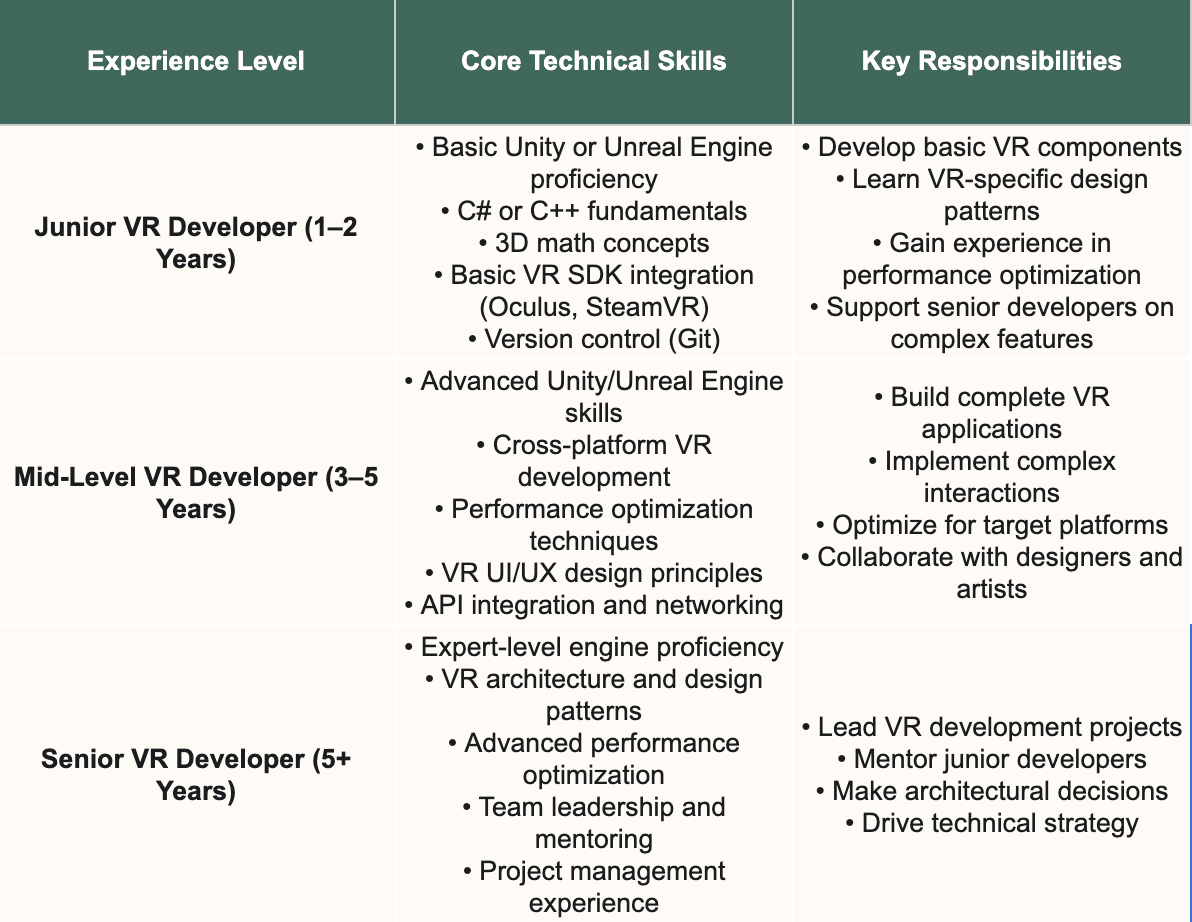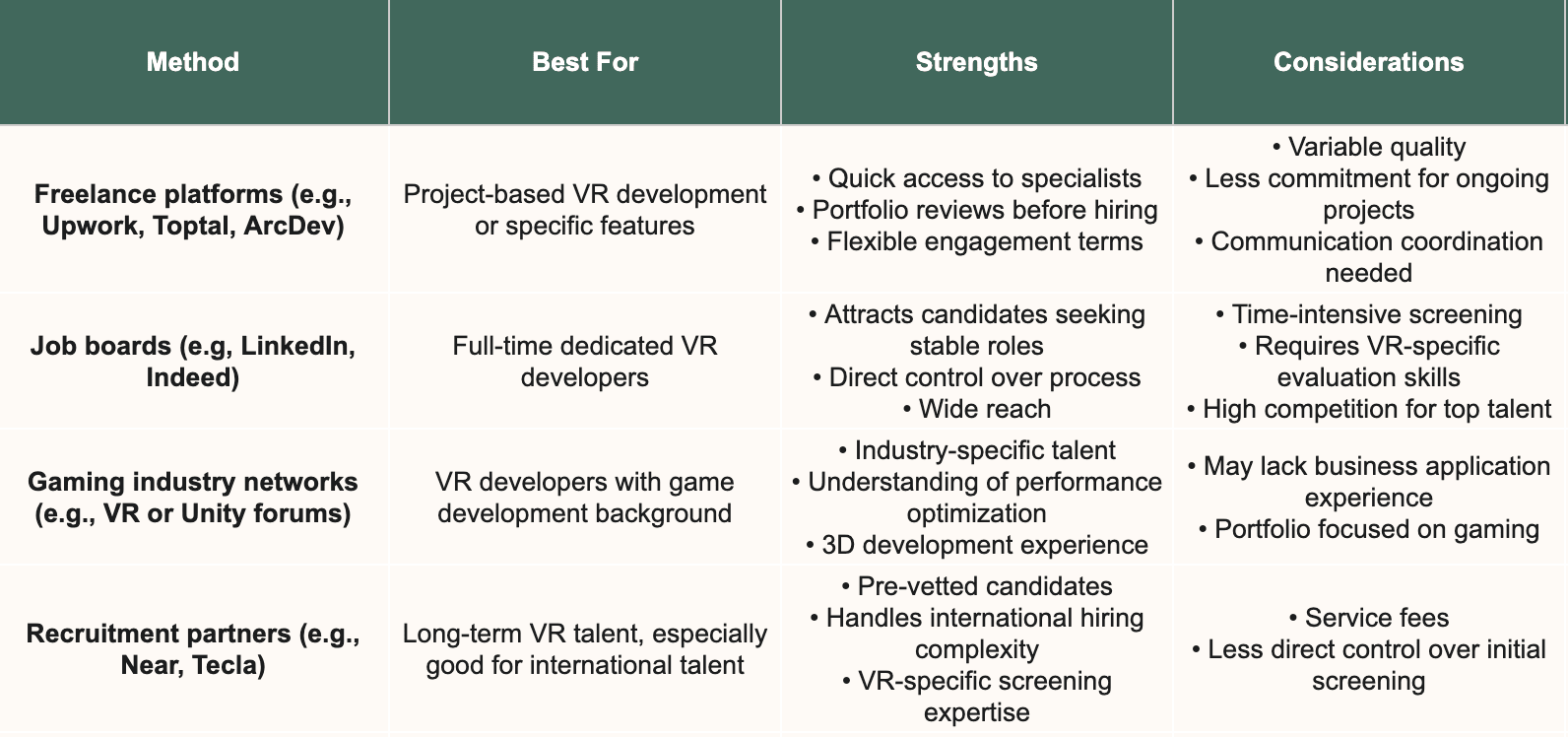Key Takeaways:
- Virtual reality developers build immersive 3D experiences using specialized engines like Unity and Unreal Engine, requiring both technical expertise and creative problem-solving skills to create seamless virtual environments.
- US VR developers earn $65,000 to $157,300 annually, while the salary expectations of skilled Latin American VR developers are up to 54% less ($36,000–$84,000), making premium talent accessible to growing companies.
- The best VR developers combine hard skills (3D programming, performance optimization) with soft skills (spatial thinking, user empathy) and can articulate complex technical concepts to non-technical stakeholders.
Your team needs to build VR functionality, but you’re not sure where to start with hiring. Do you need someone with gaming experience? And how do you even evaluate if a VR developer candidate knows what they’re talking about?
Meanwhile, every week you delay hiring means falling further behind competitors who are already shipping VR features.
But hiring the wrong person could be worse—you could end up with someone who builds technically functional VR that makes users motion sick, or burns through budget on features that don’t work on your target platforms.
This guide will walk you through everything you need to know to hire a skilled VR developer, whether you’re looking locally, nationally, or expanding your search offshore.
We’ll cover the essential skills to prioritize, realistic salary expectations, effective evaluation methods, and common pitfalls that can derail your hiring process.
What Does a Virtual Reality Developer Do?
Virtual reality developers create immersive 3D environments and applications that users can interact with through VR headsets and controllers.
They specialize in building experiences that feel natural and responsive in virtual space—from designing intuitive user interfaces that work in 3D to optimizing performance so users don’t experience motion sickness.
VR developers work with specialized game engines like Unity or Unreal Engine, implement physics systems, design spatial audio, and ensure smooth frame rates across different VR platforms. They also collaborate closely with 3D artists, UX designers, and product teams to transform concepts into functional virtual experiences.
Unlike traditional app developers, VR developers must consider unique challenges like spatial design, comfort factors, and hardware constraints that don’t exist in conventional software development.
How Much Does It Cost to Hire a Virtual Reality Developer?
VR developer salaries vary significantly based on experience level and geographic location.
In the US, virtual reality developers typically earn between $65,000 and $157,300 annually. Junior developers start around $65,000 to $104,500, while senior developers with specialized VR experience can command $119,900 to $157,300 or more.
For companies looking to access top-tier VR talent while managing budget constraints, hiring internationally provides substantial cost advantages.
For example, Latin American VR developers typically earn between $36,000 and $84,000 annually, representing up to 54% savings compared to US market rates.

These savings reflect differences in local cost of living, not differences in talent quality or technical capabilities.
Many Latin American developers have extensive experience working with US companies and are already familiar with American development practices and project management approaches.
For startups or growing companies building VR products, this cost difference can mean the ability to hire senior-level talent on a junior-level budget, or build out entire VR development teams for what one US hire might cost.
Of course, similar cost savings can be found by looking to the top countries for hiring developers in other regions like Eastern Europe and South or Southeast Asia, where strong VR development talent is also available at competitive rates.
What Skills Should You Look For When Hiring a Virtual Reality Developer?
Hiring VR developers presents unique challenges. The field blends traditional software development with specialized 3D graphics, performance optimization, and user experience design, requiring a rare combination of technical skills and creative thinking.
But before diving into specific skills, it’s important to understand that what you should prioritize depends heavily on the seniority level you’re targeting.
A junior developer might excel at implementing basic VR interactions but need guidance on performance optimization, while a senior developer should be able to architect entire VR systems and mentor others. Understanding these distinctions helps you evaluate candidates fairly and set realistic expectations.
Here’s how VR developer skills typically progress across experience levels:

Regardless of seniority level, all VR developers should demonstrate certain fundamental capabilities. Here are the core skills to evaluate:
Hard skills (the must-haves)
- VR engine proficiency: Look for strong experience with Unity 3D or Unreal Engine, the two dominant platforms for VR development. Candidates should demonstrate they can work with VR-specific features like hand tracking, teleportation systems, and spatial interfaces.
- 3D programming and mathematics: VR requires deep understanding of 3D coordinate systems, quaternions for rotations, and vector mathematics. Ask candidates to explain how they handle spatial transformations or solve common 3D geometry problems.
- Performance optimization: VR demands consistent 90+ FPS to prevent motion sickness. Strong candidates understand GPU optimization, level-of-detail systems, and how to profile and fix performance bottlenecks in real-time 3D applications.
- Cross-platform development: Different VR headsets (Meta Quest, HTC Vive, PlayStation VR) have varying capabilities and constraints. Look for experience adapting applications across multiple VR platforms while maintaining consistent user experiences.
- Programming languages: Proficiency in C# (for Unity) or C++ (for Unreal Engine) is essential. Additional scripting experience in languages like Python for pipeline tools can be valuable for larger projects.
- Version control and collaboration: VR projects involve large binary assets and complex scenes. Experience with Git LFS, Perforce, or specialized game development version control systems shows they can work effectively on team projects.
Soft skills (equally important)
- Spatial thinking: VR developers must visualize and design in three dimensions. Look for candidates who can articulate how users will navigate and interact with virtual spaces, considering comfort and usability.
- User empathy: VR can cause motion sickness or discomfort if poorly designed. The best VR developers prioritize user comfort and can balance technical possibilities with human limitations and preferences.
- Problem-solving under constraints: VR hardware has strict performance limitations. Strong candidates approach technical challenges creatively, finding elegant solutions that work within platform constraints.
- Communication skills: VR concepts can be abstract and difficult to explain. Look for developers who can clearly communicate technical decisions to designers, stakeholders, and non-technical team members.
- Iterative mindset: VR development involves frequent testing and iteration since experiences feel different in VR than on a flat screen. Candidates should demonstrate comfort with rapid prototyping and feedback incorporation.
Nice-to-have skills (the differentiators)
- Computer vision and AI: Experience with hand tracking, eye tracking, or spatial anchoring can be valuable for advanced VR applications that go beyond basic controller input.
- Physics simulation: Understanding of rigid body dynamics, collision detection, and realistic object interactions enhances the believability of virtual environments.
- Audio design: Spatial audio knowledge helps create more immersive experiences where sound contributes to presence and navigation in virtual spaces.
- UX design for VR: Understanding of VR-specific design patterns, comfort guidelines, and interaction metaphors that work well in 3D space.
- WebXR or mobile VR: Experience with browser-based VR or mobile platforms like ARCore/ARKit can be valuable for companies targeting broader audiences beyond dedicated VR headsets.
Where Can You Find and Hire Great Virtual Reality Developers?
Once you understand what skills to look for in a VR developer, your next challenge is actually finding qualified candidates. This is where many companies struggle—VR development is a specialized field with a relatively small talent pool, and the best developers often have multiple opportunities.
Your approach to sourcing VR talent will significantly impact both the quality of candidates you attract and how quickly you can fill the role.
The key is understanding your options and choosing the strategy that aligns with your timeline, budget, and project requirements.
Deciding between local, national, or global talent
Your hiring approach depends on your project timeline, budget constraints, and collaboration preferences.
Local/In-office hiring offers direct collaboration benefits, especially valuable for VR projects where hands-on testing and iteration are crucial. However, the VR developer talent pool is limited in most cities, and local candidates often command premium salaries.
Remote US-based hiring expands your options significantly while maintaining familiar time zones and cultural alignment. You’ll still face high salary expectations and competition from tech giants, but access to talent improves considerably.
International hiring opens up the largest talent pool and provides substantial cost savings. For VR development, Latin America offers particularly strong advantages: many developers have gaming or entertainment industry experience that translates well to VR, cultural alignment with US business practices, and time zone overlap for real-time collaboration.
Countries like Argentina, Mexico, and Colombia have growing game development scenes. Developers in these regions often have experience with Unity and Unreal Engine from game development, making the transition to VR development natural.
For US companies looking to maximize these benefits while minimizing potential drawbacks, hiring Latin American developers offers an ideal balance. When businesses in the US hire from nearby countries, this approach is commonly referred to as nearshoring—a strategy that helps balance cost savings, cultural compatibility, and time zone alignment.
For more insights on the strategic advantages of this approach our article on solving tech recruitment hurdles with remote LatAm talent goes into more detail.
Choosing the right sourcing channel
Once you’ve decided on your geographic approach, the next step is selecting how you’ll actually find and connect with VR developer candidates.
Each sourcing method has distinct advantages and limitations, and the right choice depends on your timeline, budget, internal resources, and hiring experience.
Here’s how the most common sourcing channels compare for VR developer hiring:

Referrals work well when you have a strong network in gaming or tech and need someone fast. Job boards are effective when you have time to screen candidates and internal technical expertise to evaluate VR skills. Freelance platforms suit project-based work or when you want to test a developer before committing to full-time hiring.
For critical VR positions or when hiring internationally for the first time, working with a recruitment partner can save significant time and avoid costly mis-hires. We’ll explore this approach in more detail later in the guide.
How to Hire the Best Virtual Reality Developer: Best Practices
Finding a great VR developer requires more than just technical screening—you need to evaluate their ability to think spatially, work within VR constraints, and create comfortable user experiences.
Here’s what to focus on:
Stage 1: Before and during sourcing
Define your VR project scope and priorities
VR development spans entertainment, training, visualization, and enterprise applications—each requiring different skill emphases. Are you building an immersive training simulation that prioritizes realism, a social VR experience that needs robust networking, or a product visualization tool that demands visual fidelity?
Be specific about your target platforms. Quest development requires mobile optimization skills, while PC VR allows for more complex graphics and interactions.
Also clarify whether you need someone who can handle the full VR development pipeline or if you have 3D artists and designers who will handle assets and UI design separately.
Craft a job description that attracts VR talent
Your job description should emphasize the creative and technical challenges that excite VR developers. Instead of generic requirements like “3+ years experience,” specify “experience optimizing Unity applications for consistent 90 FPS on mobile VR platforms” or “proven track record implementing comfortable locomotion systems.”
Include details about your VR project’s purpose and impact. VR developers are often passionate about the technology’s potential—they want to know their work will create meaningful experiences, not just check technical boxes.
Don’t forget to mention your testing setup and hardware. VR developers want to know they’ll have access to the latest headsets and development tools to create and test their work effectively.
For more guidance on creating an effective job description, check out our guide on how to write a job description for a software developer.
Stage 2: Screening and evaluation
Evaluate VR-specific problem-solving skills
VR development involves unique technical challenges that don’t exist in traditional software development. During interviews, present scenarios like “How would you implement a teleportation system that feels comfortable for users prone to motion sickness?”
Look for developers who can break down spatial concepts and performance considerations in accessible terms.
Consider giving candidates a small paid test project—perhaps implementing a basic interaction system or optimizing a provided VR scene. This reveals their approach to VR-specific challenges and quality of their code.
Assess spatial design understanding
Great VR developers think beyond code to consider user experience in 3D space. Ask questions like “How do you decide where to place UI elements in a VR environment?” or “What factors do you consider when designing hand interactions for users of different heights?”
Their answers should demonstrate understanding of VR comfort guidelines, accessibility considerations, and how virtual space differs from traditional screen-based interfaces.
Look for performance optimization experience
VR’s strict performance requirements mean candidates must understand GPU optimization, efficient rendering techniques, and profiling tools. Ask them to describe a specific situation where they had to solve a performance problem in a VR application.
Strong candidates will discuss techniques like frustum culling, level-of-detail systems, texture optimization, or reducing draw calls. They should also understand the trade-offs between visual quality and performance in VR contexts.
Stage 3: Making the offer and closing the deal
Structure competitive offers for VR talent
VR developers often have options across gaming, entertainment, and emerging tech companies.
Beyond competitive base salary, consider what matters most to VR professionals: access to cutting-edge software/hardware, opportunities to work on innovative projects, and professional development budget for VR conferences and training.
Based on our experience placing dev talent, work-life balance, learning opportunities, and having ownership of their work matter most to candidates beyond just salary.
If you’re hiring internationally, be transparent about equipment provisioning—VR developers need access to the latest headsets and development hardware to do their best work.
Move quickly on strong candidates
The VR developer market is competitive, especially for senior talent with proven experience. Once you’ve identified a candidate who fits your technical needs and team culture, move decisively. Great devs often has multiple opportunities and appreciate companies that can make decisions efficiently.
Clearly communicate your VR project’s roadmap and growth opportunities. Many VR developers are motivated by the chance to shape emerging technology and want to understand how their role will evolve as your VR initiatives expand.
{{hiring-remotely}}
Top Interview Questions for Hiring Virtual Reality Developers That Reveal the Right Fit
“Describe how you would approach building a VR application from concept to deployment.”
This question reveals their understanding of the full VR development pipeline. Look for candidates who mention user research, prototyping for VR constraints, iterative testing with actual headsets, performance optimization throughout development, and platform-specific deployment considerations.
Strong answers should acknowledge that VR development requires more iteration than traditional software since experiences can’t be fully evaluated without putting on a headset.
“Walk me through how you’d debug a performance issue causing frame drops in VR.”
VR’s strict performance requirements make optimization skills critical. Candidates should demonstrate systematic approaches: profiling tools usage, identifying bottlenecks (CPU vs GPU), and specific optimization techniques like reducing draw calls, optimizing textures, or implementing level-of-detail systems.
Listen for understanding that VR performance issues directly impact user comfort and can cause motion sickness—it’s not just about technical benchmarks.
“How do you ensure your VR experiences are comfortable for users with different tolerances for motion?”
This question tests their understanding of VR-specific UX considerations. Strong candidates will discuss comfort settings, multiple locomotion options, snap vs smooth turning, and following platform comfort guidelines.
They should demonstrate awareness that what feels fine to a developer who uses VR daily might cause discomfort for new users.
“Explain a complex VR interaction you’ve implemented and the technical challenges involved.”
Look for detailed technical explanations that show hands-on VR development experience. They should discuss spatial tracking, hand/controller input handling, physics integration, and user feedback systems.
One of our top recruiters recommends asking candidates to explain technical concepts to someone who might not understand—if they can’t, it’s because they’re just repeating things without actually understanding the work.
“How do you handle version control and collaboration on VR projects with large 3D assets?”
VR projects involve large binary files that standard Git doesn’t handle well. Experienced candidates will discuss Git LFS, Perforce, or Unity’s Collaborate features, and understand the challenges of merging scenes with multiple developers.
This question also reveals their experience working on team projects rather than solo development.
Common Mistakes to Avoid When Hiring Virtual Reality Developers
1. Prioritizing general programming skills over VR-Specific experience
Many companies treat VR development like traditional software development with some 3D thrown in. While strong programming fundamentals matter, VR involves unique considerations around spatial design, performance optimization, and user comfort that require specific experience.
A great web developer or mobile app developer doesn’t automatically make a great VR developer. Look for candidates who understand VR-specific challenges like maintaining the right FPS, designing comfortable interactions, and working within hardware constraints.
2. Requiring formal degrees over demonstrable skills
Many companies automatically filter out candidates without computer science degrees, potentially missing developers who learned through alternative paths.
In our experience placing hundreds of candidates in development fields, a lot of the good engineers don’t have a degree, and that doesn’t mean they’re bad candidates or worse than someone who has a degree.
This is particularly true in VR, where practical experience often matters more than formal education.
VR development is a relatively new field where many of the best practitioners are self-taught or learned through game development, online courses, or bootcamps. What matters is whether they can build smooth, comfortable VR experiences—not where they learned to do it.
Focus on skills-based evaluation instead. Can they optimize for VR performance requirements? Do they understand spatial design principles? Can they implement comfortable locomotion systems? These capabilities matter far more than academic credentials.
During your evaluation process, prioritize portfolio projects, technical assessments, and practical problem-solving over educational background. You’ll often find that developers who taught themselves VR development show exceptional motivation and real-world problem-solving abilities.
And, as an added bonus, “employees hired based on skills have been shown to stay with their companies 9% longer compared to those hired through traditional methods,” according to SHRM Labs.
3. Focusing only on technical skills while ignoring design sensibility
VR is inherently experiential—the best VR developers think like designers as well as programmers. They consider user comfort, spatial relationships, and how interactions feel rather than just whether they work technically.
During interviews, ask about their design decision-making process and how they approach user experience challenges. Look for candidates who can balance technical possibilities with user needs and comfort requirements.
4. Overlooking platform-specific constraints and requirements
Different VR platforms have vastly different capabilities and limitations. Quest development requires mobile-level optimization, while PC VR allows for more complex graphics. Some candidates may have experience with only one ecosystem.
Be clear about your target platforms and assess whether candidates understand the specific constraints and optimization techniques required for your chosen hardware. Cross-platform experience is valuable but not always necessary if you’re focusing on a single platform.
Why Working With a Recruiting Partner Makes a Difference
You can absolutely find great VR developers on your own, and many companies successfully hire VR talent through direct recruiting efforts. If you have experience evaluating VR-specific skills and time to source from specialized communities, a DIY approach can work well.
However, VR development is a specialized field that sits at the intersection of gaming, 3D graphics, and emerging technology. Finding candidates requires looking beyond traditional job boards into gaming communities, VR developer forums, and specialized talent networks.
This is particularly true when hiring internationally. Navigating global talent markets, understanding regional differences in VR education and experience, and managing international hiring logistics can be complex for first-time offshore hiring.
A recruitment partner with experience sourcing offshore developers can accelerate your search by:
- Accessing specialized VR developer networks and communities
- Screening for both technical VR skills and cultural fit for remote collaboration
- Handling international compliance and contract structure for global hires
- Providing market intelligence on VR developer salary expectations and availability
When hiring for critical VR positions or building out VR teams quickly, the expertise and network access that specialized recruiters provide often justifies the investment—especially when expanding into new geographic markets for the first time.
Final Thoughts
The right VR developer becomes a key player in bringing your immersive experiences to life. They’ll combine technical expertise with spatial thinking to create virtual environments that feel natural, comfortable, and engaging for users.
But finding that developer requires looking beyond traditional programming skills to assess their understanding of 3D development, performance optimization, and user experience in virtual space.
Whether you need someone to build training simulations, product visualizations, or cutting-edge VR applications, investing in the right VR talent enables you to create experiences that truly leverage the power of virtual reality.
If working with a recruitment partner seems like the right approach for your needs, consider a specialized firm that can make the VR hiring process seamless, efficient, and stress-free.
At Near, we match you with pre-vetted Latin American VR developers who have the specialized skills your projects demand, work during your business hours, and integrate seamlessly with your development team.
Our candidates bring experience you need at rates up to 54% lower than US-based developers, without sacrificing the quality and innovation your VR projects require.
Ready to find a VR developer who can transform your concepts into immersive reality? Book a free consultation call with our team today, and we’ll help you find the perfect match within 21 days.
Frequently Asked Questions
What does a virtual reality developer do?
A virtual reality developer builds interactive 3D environments and applications that users experience through VR headsets. They use engines like Unity or Unreal Engine to create immersive scenes, design input systems for hand controllers or gesture tracking, and optimize performance for smooth, responsive user experiences.
How much does it cost to hire a virtual reality developer?
In the US, VR developers typically earn between $65,000 and $157,300 annually depending on experience and platform specialization. Hiring internationally—particularly in Latin America—can reduce costs by up to 54%, with equivalent talent earning $36,000 to $84,000 per year. Full project costs vary based on scope and complexity.
Which platforms do VR developers build for?
VR developers commonly build for platforms such as Meta Quest (formerly Oculus Quest), HTC Vive, PlayStation VR, and PC-based headsets like Valve Index.
They often need to adapt applications across these devices using SDKs and optimization techniques tailored to each hardware system’s constraints.
When should you hire a specialist Unity developer, an Unreal Engine developer, or a VR developer?
It depends on the type of VR experience you're building and which engine best aligns with your goals. Hiring a Unity developer is a great fit if you're targeting mobile VR platforms like Meta Quest or need rapid prototyping.
Unity’s versatility and large asset store make it ideal for startups and indie projects.
On the other hand, if you're building a graphically intensive experience—think high-end simulations or cinematic content—hiring a Unreal Engine developer may be the better choice. Unreal offers superior out-of-the-box visuals and is often preferred for enterprise training, architecture, and gaming.
A VR developer typically specializes in one or both of these engines but brings additional experience in spatial UX, motion control, and performance optimization for headsets. If you’re not sure which engine is right for your project, start by defining your platform, goals, and level of visual fidelity. From there, you can determine which type of developer—or combination—is the best fit.
What’s the difference between VR and AR development?
Virtual reality (VR) fully immerses users in a simulated 3D environment, while augmented reality (AR) overlays digital content onto the real world using devices like phones, tablets, or AR glasses.
VR developers focus on spatial design and performance in headset-based environments, while AR developers work more with computer vision and device sensors.
What skills are most important when hiring a VR developer?
Key skills include proficiency in Unity or Unreal Engine, 3D math and spatial reasoning, C# or C++ programming, GPU and rendering optimization, and cross-platform deployment. Soft skills like spatial UX design awareness, iterative problem-solving, and the ability to communicate abstract concepts clearly are equally critical.













.png)






%20(1).png)
%20(1).png)
